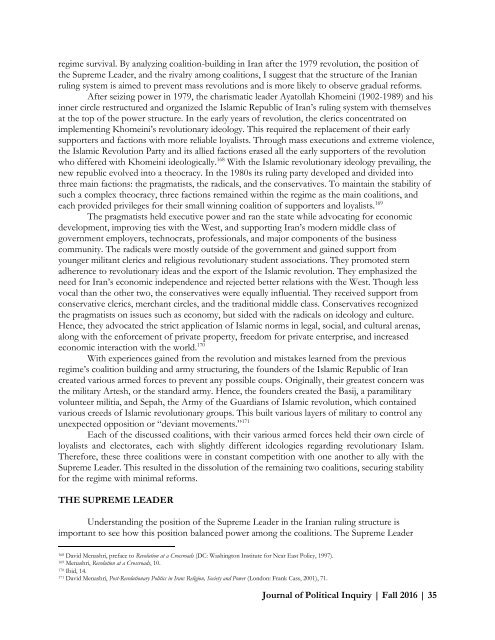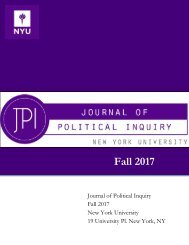Fall2016_Final2
You also want an ePaper? Increase the reach of your titles
YUMPU automatically turns print PDFs into web optimized ePapers that Google loves.
egime survival. By analyzing coalition-building in Iran after the 1979 revolution, the position of<br />
the Supreme Leader, and the rivalry among coalitions, I suggest that the structure of the Iranian<br />
ruling system is aimed to prevent mass revolutions and is more likely to observe gradual reforms.<br />
After seizing power in 1979, the charismatic leader Ayatollah Khomeini (1902-1989) and his<br />
inner circle restructured and organized the Islamic Republic of Iran’s ruling system with themselves<br />
at the top of the power structure. In the early years of revolution, the clerics concentrated on<br />
implementing Khomeini’s revolutionary ideology. This required the replacement of their early<br />
supporters and factions with more reliable loyalists. Through mass executions and extreme violence,<br />
the Islamic Revolution Party and its allied factions erased all the early supporters of the revolution<br />
who differed with Khomeini ideologically. 168 With the Islamic revolutionary ideology prevailing, the<br />
new republic evolved into a theocracy. In the 1980s its ruling party developed and divided into<br />
three main factions: the pragmatists, the radicals, and the conservatives. To maintain the stability of<br />
such a complex theocracy, three factions remained within the regime as the main coalitions, and<br />
each provided privileges for their small winning coalition of supporters and loyalists. 169<br />
The pragmatists held executive power and ran the state while advocating for economic<br />
development, improving ties with the West, and supporting Iran’s modern middle class of<br />
government employers, technocrats, professionals, and major components of the business<br />
community. The radicals were mostly outside of the government and gained support from<br />
younger militant clerics and religious revolutionary student associations. They promoted stern<br />
adherence to revolutionary ideas and the export of the Islamic revolution. They emphasized the<br />
need for Iran’s economic independence and rejected better relations with the West. Though less<br />
vocal than the other two, the conservatives were equally influential. They received support from<br />
conservative clerics, merchant circles, and the traditional middle class. Conservatives recognized<br />
the pragmatists on issues such as economy, but sided with the radicals on ideology and culture.<br />
Hence, they advocated the strict application of Islamic norms in legal, social, and cultural arenas,<br />
along with the enforcement of private property, freedom for private enterprise, and increased<br />
economic interaction with the world. 170<br />
With experiences gained from the revolution and mistakes learned from the previous<br />
regime’s coalition building and army structuring, the founders of the Islamic Republic of Iran<br />
created various armed forces to prevent any possible coups. Originally, their greatest concern was<br />
the military Artesh, or the standard army. Hence, the founders created the Basij, a paramilitary<br />
volunteer militia, and Sepah, the Army of the Guardians of Islamic revolution, which contained<br />
various creeds of Islamic revolutionary groups. This built various layers of military to control any<br />
unexpected opposition or “deviant movements.” 171<br />
Each of the discussed coalitions, with their various armed forces held their own circle of<br />
loyalists and electorates, each with slightly different ideologies regarding revolutionary Islam.<br />
Therefore, these three coalitions were in constant competition with one another to ally with the<br />
Supreme Leader. This resulted in the dissolution of the remaining two coalitions, securing stability<br />
for the regime with minimal reforms.<br />
THE SUPREME LEADER<br />
Understanding the position of the Supreme Leader in the Iranian ruling structure is<br />
important to see how this position balanced power among the coalitions. The Supreme Leader<br />
168<br />
David Menashri, preface to Revolution at a Crossroads (DC: Washington Institute for Near East Policy, 1997).<br />
169<br />
Menashri, Revolution at a Crossroads, 10.<br />
170<br />
Ibid, 14.<br />
171<br />
David Menashri, Post-Revolutionary Politics in Iran: Religion, Society and Power (London: Frank Cass, 2001), 71.<br />
Journal of Political Inquiry | Fall 2016 | 35
















